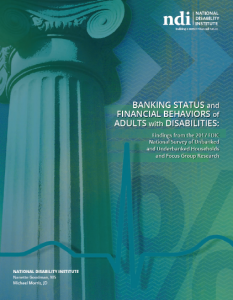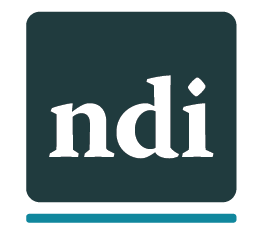Today, National Disability Institute (NDI) released the new report, Banking  Status and Financial Behaviors of Adults with Disabilities: Findings from the 2017 FDIC National Survey of Unbanked and Underbanked Households. The report finds that, in the 29 years since the landmark Americans with Disabilities Act (ADA) was signed into law, ensuring all individuals with disabilities the opportunity to achieve “economic self-sufficiency,” this population still faces numerous financial hurdles and roadblocks to financial inclusion.
Status and Financial Behaviors of Adults with Disabilities: Findings from the 2017 FDIC National Survey of Unbanked and Underbanked Households. The report finds that, in the 29 years since the landmark Americans with Disabilities Act (ADA) was signed into law, ensuring all individuals with disabilities the opportunity to achieve “economic self-sufficiency,” this population still faces numerous financial hurdles and roadblocks to financial inclusion.
Based on data mined from the 2017 FDIC National Survey on Unbanked and Underbanked Households, this insightful report highlights the financial choices and banking habits of adults with disabilities. This is the third report, based on FDIC data, that NDI has released in five years.
“Americans with disabilities face unique financial obstacles and challenges that separate them from their peers without disabilities,” National Disability Institute Executive Director, Michael Morris, said. “Today, with the release of this report, we now have a clearer picture of the challenges they face, but also the significant opportunities to design solutions.” Continued Mr. Morris, “It is essential that policymakers, financial institutions and community organizations rally around the report’s findings and recommendations, and begin to work together to ensure equal access and financial inclusion for people across the spectrum of disabilities.”
The report findings provide an important lens on the financial choices and decision making of Americans with disabilities. Report highlights include:
- Households with a disability were three times as likely to be unbanked as households with no disability (18 percent versus 6 percent). The “disability gap” has increased since 2011.
- Twenty-five percent of households had a bank account, but used a service that either: (1) the bank did not offer; (2) the bank offered, but the household did not qualify; or (3) was offered elsewhere at a lower price or with more convenience.
- Households with disabilities were more likely to rely on bank tellers and less likely to use online or mobile options. Thirty-seven percent of households with a disability used online or mobile as the primary method to access their account compared with 62 percent of households with no disability.
- Only 38 percent of households with a disability saved for unexpected expenses or emergencies in the past 12 months compared with 63 percent of households with no disability.
- Compared to households without a disability, those with a disability were much less likely to have a credit card, store credit, mortgage or home equity, auto loan or student loan. Almost one in five households with disabilities had an unmet need for credit.
National Disability Institute released the report findings today during a national webinar.
A digital copy of the report is available for download from the NDI website.
The research and report were made possible through the generous support of JPMorgan Chase.
